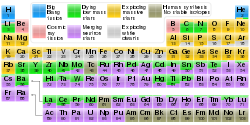Cosmic ray spallation
| Nucleosynthesis |
|---|
 |
| Related topics |
Cosmic ray spallation, also known as the x-process, is a set of naturally occurring nuclear reactions causing nucleosynthesis; it refers to the formation of chemical elements from the impact of cosmic rays on an object. Cosmic rays are highly energetic charged particles from beyond Earth, ranging from protons, alpha particles, and nuclei of many heavier elements. About 1% of cosmic rays also consist of free electrons.
Cosmic rays cause
The process

Cosmic ray spallation is thought to be responsible for the abundance in the universe of some light elements—lithium, beryllium, and boron—as well as the isotope helium-3. This process (cosmogenic nucleosynthesis) was discovered somewhat by accident during the 1970s: models of Big Bang nucleosynthesis suggested that the amount of deuterium was too large to be consistent with the expansion rate of the universe and there was therefore great interest in processes that could generate deuterium after the Big Bang nucleosynthesis. Cosmic ray spallation was investigated as a possible process to generate deuterium. As it turned out, spallation could not generate much deuterium, but the new studies of spallation showed that this process could generate lithium, beryllium and boron; indeed, isotopes of these elements are over-represented in cosmic ray nuclei, as compared with solar atmospheres (whereas hydrogen and helium are present in about primordial ratios in cosmic rays).
An example of cosmic ray spallation is a neutron hitting a nitrogen-14 nucleus in the Earth's atmosphere, yielding a proton, an alpha particle, and a beryllium-10 nucleus, which eventually decays to boron-10. Alternatively, a proton can hit oxygen-16, yielding two protons, a neutron, and again an alpha particle and a beryllium-10 nucleus. Boron can also be created directly. The beryllium and boron are brought down to the ground by rain.[1] See Cosmogenic nuclide for a list of nuclides produced by cosmic ray spallation.
The x-process in cosmic rays is the primary means of nucleosynthesis for the five stable isotopes of lithium, beryllium, and boron.
In addition to the above light elements,
The timing of their formation determines whether nuclides formed by cosmic ray spallation are termed primordial or are termed cosmogenic (a nuclide cannot belong to both classes). The stable nuclides of lithium, beryllium, and boron found on Earth are thought to have been formed by the same process as the cosmogenic nuclides but at an earlier time in cosmic ray spallation predominantly before the Solar System's formation, and thus they are by definition
See also
- Cosmic rays
- Cosmogenic nuclide
- Nuclear fission
- Nucleosynthesis
- Astrophysics
- spalling
- Spallation
- Spallation Neutron Source
- ISIS neutron source
- PSI Spallation Neutron Source (SINQ)
References
- ^ Sapphire Lally (Jul 24, 2021). "How is gold made? The mysterious cosmic origins of heavy elements". New Scientist.
- ^ a b Greenwood & Earnshaw 1998, pp. 13–15.
- S2CID 119230483.
- S2CID 203610207.
- ISBN 978-0-7506-3365-9.
Further reading
- Meneguzzi, M.; Audouze, J.; Reeves, H. (1971). "The production of the elements Li, Be, B by galactic cosmic rays in space and its relation with stellar observations". Bibcode:1971A&A....15..337M.
External links
- California Institute of Technology: The Cosmic Ray Isotope Spectrometer (CRIS)
- Department of Physics and Astronomy, University of Leeds: Is the cosmic-ray residence time E^-0.6 (spallation) or E^-(1/3) (anisotropy, turbulence)?
- Ultra Heavy Cosmic Ray Propagation Using New Spallation Cross-Section Expressions
- Evidence for cosmic ray spallation production of helium and neon found in volcanoes
